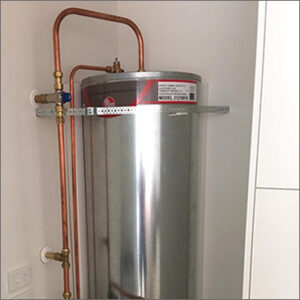What exactly is grey water?
Grey water is the “used” wastewater from bathtubs, showers, bathroom wash basins, washing machines, laundry tubs, dishwashers.
Grey water is NOT the water from toilets. This is referred to as black water as it usually contains solids (excrement, toilet paper, sanitary products). The process for treating black water is different from the process used for making grey water useable – black water must go into the mains sewage system.
Is grey water potable?
You might hear people in the plumbing or water sectors talk about “potable” water. Potable water is water that is safe for consumption – water that is safe to drink, cook with, brush your teeth with, wash and shower with, give to your pets, fill your pool or spa with. Any water that is going to be consumed or potentially swallowed – by you or your pets – should be potable to prevent illness or infection.
Grey water is NOT potable water. Even though you cannot safely consume grey water, there are still many uses for it. If you’re interested in reducing your water usage or would like to “recycle” some of the water your household uses, we suggest you look into how to make the most of your grey water.
Re-using grey water without filtering it
In light of the water shortages that Auckland is experiencing, re-using grey water is an excellent way to cut down on your water usage. Like many other areas of our daily living, more and more people are looking for ways to reduce their consumption, save money, and look after our natural resources. Reducing our water use is a great way to introduce “recycling” into another area of day-to-day living.
There are ways to use grey water with and without council approval. *
Using your grey water without approval or consent from Auckland council involves manually collecting some of your grey water in areas where there is no risk of contamination or risk to the health and safety of people on the property. This must be done reasonably quickly after grey water collection (within 24 hours).
You can capture the grey water from your washing machine, shower, basin, etc in a bucket, pail, tub, etc and use it to:
- wash muddy gumboots, soccer/rugby boots, etc
- water plants or non-edible parts of your garden (not the vegetable or herb garden; and preferably if you use eco-friendly soaps or detergents)
- wash or rinse equipment (wheelbarrow, shovels, garden utensils) or vehicles (depending on how dirty the water is)
- wash down pavement
Always minimise or eliminate direct human contact with the grey water, and always try to use it immediately after collection. An easier way to re-use your grey water is to install a grey water system.
When you need Council approval to use grey water
Grey water use can be extended through the use of a grey water tank or system. A grey water tank is different from a septic tank, as a septic tank receives and treats all water (including black water).
You do need council consent for a grey water system as it must comply with Building Code requirements to ensure that it is installed, used and maintained correctly, safely, without risk of contamination.
A grey water system diverts (either by gravity or with a pump) the used water from basins, showers, washing machines, etc to a surge tank. This is a tank that the water is initially held in as it is collected from the various sources. This is not where it is held long-term.
The surge tank must be sealed (with no chance of rodents or bugs entering), vented, have an overflow mechanism, and must discharge into the sewer. The surge tank filter(s) must be changed, and the water in the tank emptied regularly, so that soap scrum doesn’t putrefy and bacteria or other microbial contaminants do not form.
Water from the surge tank must be treated before use. Treatment might include removing solids, chemical disinfection, and other methods to make the water safe for re-use.
It is strongly recommended that you do not allow water that potentially might contain human waste to enter the grey water system. This includes water from children’s baths or from the basin where you rinse/wash nappies or children’s soiled underpants. This should be treated as black water.
Who can install a grey water tank?
Regency Plumbing can evaluate whether your existing property layout is suitable for a grey water system. If it is, we can do the set-up for you. We strongly recommend that you don’t try to do this yourself, as it must comply with the Building Code. You may also need resource consent for any discharges of grey water.
If you’re having a new home built, the Regency Plumbing team can help design the best system to easily integrate into your build plans. Despite the approvals that might be required in your area, we recommend looking into re-using your grey water to help reduce water use in Auckland.
Give Regency Plumbing a call and we can start looking into it for you.
* Note, the advice given here is meant for guidance and general information. Please consult with your local council or water provider for information that applies to your particular situation and location.

